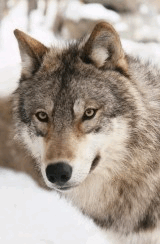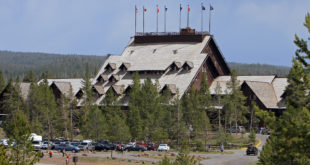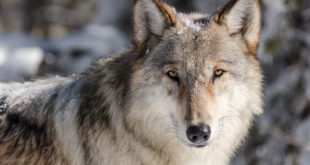 The gray wolf (also, Timberwolf) canis lupus. In the west, the northern sub-species was canis lupus irremotus — the Rocky Mountain Wolf. Other wolves in North America include the lobo, or Mexican wolf, canis lupus baileyi, Great Plains Wolf, canis lupus nubilus, and Eastern Timberwolf, canis lupus lycoan. Some maintain that the wolf re-introduced in Yellowstone is the larger Alaskan sub-species, the MacKenzie Wolf, canis lupus occidentalis. The taxonomy (naming of species and sub-species) and cladistics (classification of organisms) of wolves is an area of public confusion and scientific debate, which is now being sorted out by DNA comparisons.
The gray wolf (also, Timberwolf) canis lupus. In the west, the northern sub-species was canis lupus irremotus — the Rocky Mountain Wolf. Other wolves in North America include the lobo, or Mexican wolf, canis lupus baileyi, Great Plains Wolf, canis lupus nubilus, and Eastern Timberwolf, canis lupus lycoan. Some maintain that the wolf re-introduced in Yellowstone is the larger Alaskan sub-species, the MacKenzie Wolf, canis lupus occidentalis. The taxonomy (naming of species and sub-species) and cladistics (classification of organisms) of wolves is an area of public confusion and scientific debate, which is now being sorted out by DNA comparisons.
In general, the height of wolves varies from 26–38 inches (6 to 9.5 centimeters) at the shoulder and weight ranges from 70–135 pounds (32 to 62 kg), which together make the gray wolf the largest of all wild canids. (Some species of canids, mostly human bred dogs like English Mastiffs and Saint Bernards, are larger.)
Dogs are the genetic descendants of wolves, both belonging to the canid family. In general wolves are larger than most domestic dogs, have a fuller face and snout, and a bushier tail. Wolves and dogs share most basic behavior, although human bred and trained species of dogs can behave in ways unknown to wild wolves.
Intelligence: The wolf is one of the most adaptable and intelligent of predators, and has shown the ability to survive in a very wide range of habitat: desert, sub-arctic, alpine, prairie (steppe), and temperate forest. The cleverness of wolves is legendary, as they have shown a sophisticated ability to solve problems, communicate, and anticipate situations.
Mobility: In daily life, especially as a hunter, the wolf is an indefatigable traveler. Built for both long-distance endurance and short sprinting, the powerful legs and body musculature make it possible for wolves to cover several miles at a pace of 6 mph (10 km/h) and produce burst speeds up to 40 mph (65 km/h). Wolf packs can range hundreds of miles patrolling and exploring their territory. Pursuing large prey may also cover many miles and particularly in winter can be exhausting.
 Group Behavior: Perhaps the best known — and feared — wolf behavior is as a pack. Packs are a sophisticated and often complex social group, essentially a hierarchy (tempting to say pecking order, but that somehow doesn’t fit the dignity of a wolf) but a hierarchy that can have a surprising degree of shared responsibility and role playing, especially in the larger packs.
Group Behavior: Perhaps the best known — and feared — wolf behavior is as a pack. Packs are a sophisticated and often complex social group, essentially a hierarchy (tempting to say pecking order, but that somehow doesn’t fit the dignity of a wolf) but a hierarchy that can have a surprising degree of shared responsibility and role playing, especially in the larger packs.
The head of almost every pack is a pair of dominant wolves — the alpha male and alpha female or alpha pair. This is also referred to as the breeding pair, because as a rule they are the pair in the pack to have pups. Starting with the alpha pair there is a rank order for each wolf in the pack down to the lowest individual, the omega wolf. Relationships in this hierarchy are constantly tested and personality conflicts do occur, sometimes resulting in the dispersal of wolves or even in the killing of individuals.
Pack Life: Wolves don’t always live in packs (think of the legendary lone wolf), but living alone is temporary for most wolves. Packs range in size from 2 (+pups) up to 30 (rare) with an average pack being about 8 individuals. Packs often change size and sometimes disappear, especially when the alpha pair dies. In the Greater Yellowstone Region new packs are formed and old packs disperse every year.
Pack life covers almost every aspect of wolf behavior, but from a survival point of view, hunting and pup-rearing are vital. While an individual wolf can hunt and kill small animals, it’s the packs that are successful in hunting the large ungulates (elk, bison, deer, moose), which are the preferred diet. While individual female wolves (usually the mother) can and do protect and nurture wolf pups, packs also take on the responsibility and are generally more effective. One of the threats to wolf pups are wolves from other packs, in fact, fighting between wolf packs is common and may lead to fatalities. A well known part of wolf behavior, howling, is often associated with territorial positioning — letting the neighbors know who’s who.
Wolves make a variety of vocalizations: howl, bark, growl, and whimper. Used together with body language, wolves have a sophisticated ability to communicate among themselves — probably an evolutionary development to further the group (pack) socializing and the ability to hunt as a pack.
Prey: Survival in the harsh climate of Yellowstone requires an innate sense for conservation of energy. Put simply this means expending the least amount of energy to accomplish a task. If a wolf sees two elk, one a robust, rompin’ and stompin’ male, the other a wobble-kneed calf, which is the target? It’s a no-brainer for the wolf as well.
With exceptions, older, sicker, weaker, younger animals are the favored prey. They require less energy to bring down and are usually less dangerous. Wolves do get hurt on the hunt. Tackling big animals with horns like bison and elk is not without risk. Anything but a trivial injury is life-threatening to a wolf, so the risk is great. In Yellowstone, around 85-90 percent of a wolf’s diet comes from elk, with the other portion being filled by prey of opportunity such as deer, moose, and mountain sheep. Antelope would also be prey, but unless sick or very young, antelope can easily outrun a wolf. Wolves also take smaller prey such as rabbits and ground squirrels, especially in summer.
Life and Death: Female wolves conceive once a year during the mating season (from January to April) and can produce a litter from 1 to 14 pups with 4 to 6 being the average. Pups are usually born during the spring in a hole in the ground, a den, and remain there for no more than eight weeks. During this time pups are totally vulnerable and can fall prey to bears, coyotes, and other wolves. Wolves are also subject to disease, such as canine parvo-virus, which is usually hardest on the pups. Wolves reach maturity in 2 to 3 years and in most habitats can live from 6-8 years. There is a relatively high mortality rate, much of it due to the vulnerability of pups to disease. Older wolves die from: Hunting, car accidents, prey-hunting wounds, other wolves, and disease. Very few wolves in the wild die from old age, upwards of 12 to 15 years.
MORE ON WOLVES….
Wolves in Yellowstone: A Short History
Wolf Attacks on People
When and Where to See Wolves
Greater Yellowstone Ecosystem Wolf Pack Map 2008
Issues: How Many Wolves are Enough?
 Yellowstone Insider Your Complete Guide to America's First National Park
Yellowstone Insider Your Complete Guide to America's First National Park






